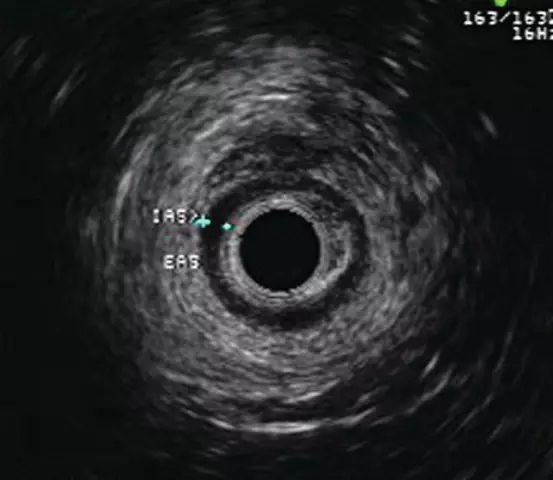- Author Rachel Wainwright [email protected].
- Public 2023-12-15 07:39.
- Last modified 2025-11-02 20:14.
Anal sphincter

The main function of the anal sphincter is to control the secretion of intestinal contents. It consists of an external and an internal part.
External anal sphincter
The outer part of the sphincter is an annular structure of striated musculature surrounding the anal canal. The external sphincter can be controlled by a person's consciousness.
It is 8-10 cm long and 2.5 cm thick. The striated muscles of the sphincter pass the pubic-rectal muscle.
The muscles of the outside of the sphincter are divided into three layers:
- Subcutaneous muscles, which are circular muscles;
- Superficial muscle - an elliptical muscle attached to the coccyx;
- Deep muscle, closely associated with the pubic-rectal muscle.
The muscles in the outer anus wrap around the lower part of the inner sphincter. Despite the fact that the sphincters are in close contact, there is a clear border between them.
There are stretch receptors in the muscles of the external anal sphincter. A healthy adult can easily control the passage of feces and their consistency through the sphincter. The rectoanal reflex consists in contracting the muscles of the external sphincter of the anus. The defecation reaction occurs as a result of a sharp increase in intra-abdominal pressure, as a result of which intrarectal pressure arises and the internal sphincter of the anus relaxes.
Internal anal sphincter
The inner part of the sphincter is a smooth muscle annular structure that surrounds the anal canal. It starts from the inner circular muscle layer of the rectum, and below it connects to the skin of the anus. In the lower part, the internal sphincter is wrapped around the muscles of the external sphincter.
The inner part of the sphincter is about 5 mm thick and 25-30 mm long. The lower border of the sphincter is located at a distance of about 5-6 mm from the anus. Its muscle fibers run obliquely along the axis of the intestine and to the centerline of the rectum.
Unlike the external, the internal anal sphincter is not controlled by a person's consciousness. Its relaxation and contraction occur involuntarily. Normally, the internal sphincter is contracted. Its reflex relaxation occurs as a result of irritation of the rectum with feces. Colon peristalsis does not affect the state of the sphincter.
The main function of the internal sphincter is valve, that is, it does not allow the passage of liquid faeces and gases to happen.
The valve function of the internal sphincter is carried out thanks to a three-level system:
- Intramural level;
- Spinal level;
- The suprasegmental level located in various parts of the brain.
The spinal and intramural levels are carried out by the parasympathetic and sympathetic divisions of the autonomic nervous system. Sympathetic fibers keep the sphincter in a constantly contracted state and inhibit the motor activity of the rectum. In contrast, parasympathetic fibers relax the sphincter and stimulate rectal motility.
Anal sphincter defects
The most common anal sphincter defects are:
- Insufficiency of the anal sphincter;
- Anal fissure.
Insufficiency of the anal sphincter is a complete or partial violation of voluntary retention of feces.
Normally, the sphincter is able to retain the gaseous, liquid and solid contents of the rectum not only in different body positions, but also when sneezing, severe coughing, physical exertion, etc.
The most common cause of failure is injury, mainly postoperative. Failure can also occur as a result of changes in muscle structure or neuro-reflex disorders. The most common causes of these disorders are diseases of the anal canal or rectum, such as hemorrhoids, rectal prolapse or various inflammatory diseases. Less often, malformations of the anal canal and rectum become the cause of failure.
There are three degrees of anal sphincter insufficiency:
- First degree, when the patient is unable to contain gas;
- Second degree, when the patient is unable to retain gas and liquid feces;
- The third degree is complete incontinence.
Anal fissure - injury to the mucous membrane of the anus.
Anal fissure is quite common and takes the third place among diseases of the colon (after colitis and hemorrhoids).

An anal fissure occurs as a result of various reasons. The most common cause is trauma to the mucous membrane during the passage of solid feces. The predisposing factors for its occurrence are the presence of colitis, hemorrhoids, enterocolitis, proctosigmoiditis. In almost 70% of patients, the crack is combined with chronic diseases of the upper digestive tract (stomach ulcer, gastritis, cholecystitis). The same number of patients combine anal fissure with hemorrhoids.
There are three symptoms of anal fissure:
- Light bleeding during bowel movements;
- Anal sphincter spasm;
- Pain in the anus immediately during or after a bowel movement.
Pain in the anus is characteristic of acute and chronic fissures. As a result of painful sensations, patients tend to perform the act of defecation as rarely as possible, which leads to constipation. In addition, pain can cause spasm of the anal sphincter, which, in turn, only intensifies the pain sensation. Spasm of the anal sphincter occurs in about 60% of patients with anal fissures.
The bleeding from the anus is relatively small and appears as a result of trauma to the crack. More profuse bleeding indicates the presence of hemorrhoids or swelling.
Found a mistake in the text? Select it and press Ctrl + Enter.






